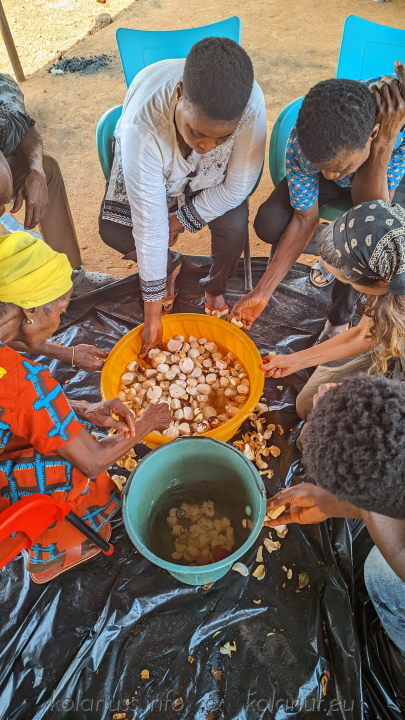Cola nuts produce flowers and fruits throughout the year, but the main harvest season is just before the rainy season. The fruits are cut from the tree using long poles with blades or simply collected from the ground. After being hacked open, the seeds are soaked to remove the white skin, revealing their vibrant colors ranging from red to pink to white. The cola nuts are then pre-dried in the shade and can be stored for months in this state. Further drying is only necessary for export.
Collecting and Cleaning
The cola nut tree bears fruit throughout the year, but the harvest time depends on the region. In Ghana, the main harvest begins in November and lasts until February, just before the rainy season, which lasts from late March to June. The trees clearly indicate the right time for harvest with a color change in the pod fruits. When their dark green color fades and becomes lighter, the farmers know that a harvest is necessary because the fruits will soon begin to open to distribute their seeds, which would invite pests to feed on them.
To harvest the fruits, poles about 3.5 meters long with curved blades are used to cut them from the tree. Sometimes, machetes are used to climb the trees and cut them directly. However, many fruits also fall to the ground on their own and can simply be collected. The harvested fruits are then hacked open with large knives or machetes to extract the seeds, which are called cola nuts.
Afterwards, the seeds are soaked in large bowls of water for about 15 minutes or piled into large heaps and sprayed with water. This helps to more easily remove the white skin that is still on the seeds. After soaking, the cola nuts appear in various colors, from red to pink to white. In this state, they can already be consumed but are not yet suitable for storage.
Fresh Kola Nuts
To make the nuts durable, another step follows, known in English as 'curing': The cola nuts are placed in baskets lined with leaves and stored in the shade for several days. They are regularly stirred and damaged or infested nuts are sorted out. This gently reduces the water content of the seeds. The sensitive surface of the peeled seeds becomes somewhat more resistant again. After this process, the cola nuts can often be stored for months under good conditions without losing quality. This is the state in which fresh cola nuts are traded and consumed throughout Africa. Further drying is not traditionally common.
Dried Kola Nuts for Food Production
Only for export to Europe or other continents and for use in the food industry is it necessary to completely dry the cola nuts. Since the export share is small compared to the African consumption of fresh cola nuts, it plays a subordinate and often unknown role. However, dried cola nuts are extremely durable. In mechanical terms, they are literally rock-hard because the seeds contain almost no fat and no water after drying. This also makes them very durable if they are not stored in a very humid environment. However, this also makes them difficult to further process. Since they are no longer suitable for consumption in this state, they are usually finely ground, at least crushed, to make beverages such as caffeinated soft drinks, baked goods, chocolate, or drink powders.

 DE
DE  EN
EN 